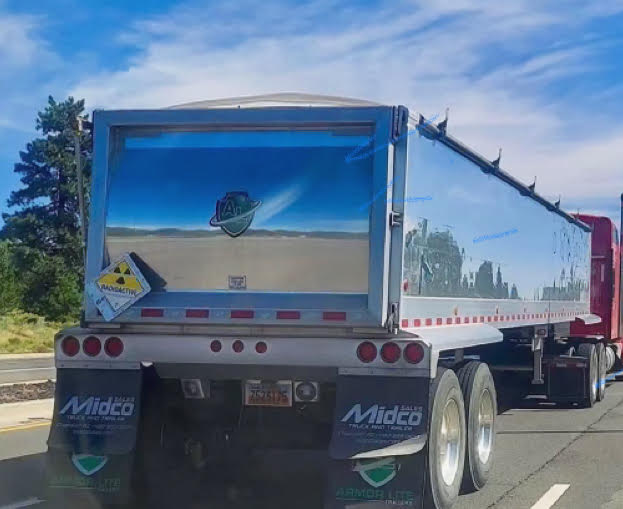
- Details
- By Donovan Quintero
WINDOW ROCK, Ariz. — Navajo Nation President Buu Nygren called the semi trucks hauling uranium ore through the Navajo Nation “illegal smugglers.”
President Nygren said his deputy chief of staff informed around 11:30 a.m. on Tuesday.
“It was so disappointing and disheartening because our people have suffered so much,” he said on Tuesday. “So as far as serving or doing our part we've done so much as far as the Navajo Nation and for people, for illegal smugglers to try to smuggle uranium across Navajo Nation, that’s just complete disrespect and they shouldn't get permission from the Navajo Nation. And at this moment in time, we don't want no uranium transportation across the nation.”
According to the U.S. Department of Agriculture Forest Service Kaibab National Forest, on the morning of Tuesday, July 30, 2024, Energy Fuels Resources informed the Kaibab National Forest that hauling uranium ore had begun earlier that morning. The forest service stated they requested an advanced notice, but there are no requirements for the mine to do so.
While the uranium ore would be hauled by truck to the White Mesa Mill near Blanding, Utah, Energy Fuels is authorized to use two haul routes. The forest service stated the company’s long-term to transport the ore would take them through State Route 64, which connects to Cameron, Arizona, Tuba City, Arizona, and U.S. Highways 180, 89, 160, and 191, which stretches through the Navajo Nation, through Kayenta, Arizona, and Mexican Water, Utah, to access the mill.
The forest service added that a portion of the route passes through state and private lands that require additional permissions.
“Until Energy Fuels obtains these permissions, the haul route will follow State Route 64 further south to I-40 at Williams then to US 89 through Flagstaff. Both routes will pass through the Navajo Nation,” states the Forest Service.
President Nygren said he directed Navajo Nation police to be stationed along U.S. Highway 89, which goes through the Navajo community of Cameron, Arizona.
“We're going to continue to monitor that if they decide to try to bring uranium Wednesday, we're going to tell them to turn around,” said President Nygren.
A 2016 map from Grand Canyon Trust, depicts the route the trucks transporting uranium ore, will take, which is about 300 miles through Arizona, the Navajo Nation, Utah, and the Ute Mountain Ute Reservation to deliver uranium ore mined at Canyon Mine (renamed Pinyon Plain Mine) to the White Mesa Mill for processing.
While a route for trucks to haul uranium ore is eight years old, the U.S. Forest Service stated back in January that Energy Fuels Resources notified the Kaibab National Forest that uranium ore had been removed from Pinyon Plain Mine and placed on an ore pad.
“This is the first time that ore has been removed from the mine. This follows notices that Energy Fuels filed with the Environmental Protection Agency on November 3, 2023, and December 14, 2023, under EPA's Approval to Construct/Modify the mine, notifying EPA of the anticipated date of initial startup of ventilation and the actual date of startup, respectively. Although this designation withdrawals the area from future mineral entry, Pinyon Plain Mine is not affected because it is a valid existing right,” states the U.S. Forest Service.
Energy Fuels cites the current high price of uranium as the reason for beginning ore production.
There are approximately 1,629,000 lbs. of Uranium 3O8 at Pinyon Plain Mine, contained in 82,800 tons of inferred resource at an average grade of 0.98% U3O8. In northern Arizona, uranium deposits are located in breccia pipes, which are vertical cylindrical bodies of broken sedimentary rock.
The mine is within the Baaj Nwaavjo I’tah Kukveni – Ancestral Footprints of the Grand Canyon National Monument. This monument was designated by the Presidential Proclamation on August 8, 2023, which was signed by President Biden at the site.
“We're already trying to clean up five hundred-plus mines, unless they want to help clean up existing mines, we're more than happy to invite them out to help us clean up the mines and then they can help us transport uranium off the Navajo Nation,” President Nygren said.
More Stories Like This
50 Years of Self-Determination: How a Landmark Act Empowered Tribal Sovereignty and Transformed Federal-Tribal RelationsTrump Veto Stalls Effort to Expand Miccosukee Tribal Lands
Oneida Nation Responds to Discovery Its Subsidiary Was Awarded $6 Million ICE Contracts
SRMT Child Support Enforcement Unit Delivers Holiday Food Boxes to Families
The Shinnecock Nation Fights State of New York Over Signs and Sovereignty
Help us defend tribal sovereignty.
At Native News Online, our mission is rooted in telling the stories that strengthen sovereignty and uplift Indigenous voices — not just at year’s end, but every single day.
Because of your generosity last year, we were able to keep our reporters on the ground in tribal communities, at national gatherings and in the halls of Congress — covering the issues that matter most to Indian Country: sovereignty, culture, education, health and economic opportunity.
That support sustained us through a tough year in 2025. Now, as we look to the year ahead, we need your help right now to ensure warrior journalism remains strong — reporting that defends tribal sovereignty, amplifies Native truth, and holds power accountable.
 The stakes couldn't be higher. Your support keeps Native voices heard, Native stories told and Native sovereignty defended.
The stakes couldn't be higher. Your support keeps Native voices heard, Native stories told and Native sovereignty defended.
Stand with Warrior Journalism today.
Levi Rickert (Potawatomi), Editor & Publisher

